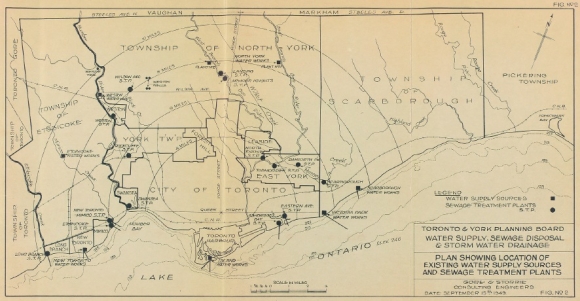The modern history of infrastructure in the Toronto region begins with the creation of Metropolitan Toronto in 1953. The new metropolitan corporation ('Metro'), faced with a growing population and expanding settlement area, but an inadequate system of roads and water/sewer services, undertook a huge program of public infrastructure expansion from about 1955 to 1970.
Working from plans developed by the venerable Toronto engineering firm Gore & Storrie, Metro built a new network of trunk sewer and water pipes throughout the metropolitan area, as well as several new treatment plants. The metropolitan corporation also widened and extended a number of arterial roads, in both the old and new urban areas, and began a program of expressway construction by building the F.G. Gardiner Expressway (1956-64) and the Don Valley Parkway (beginning 1964).
This massive public infrastructure expansion cost Metro nearly half a billion dollars from 1955 to 1970, most of which was raised by selling bonds in New York money markets. Upper level government subsidies were few, and small, until the very end of this period of growth. The province of Ontario did partially subsidize road construction, and played an important role on its own by building the Highway 401 by-pass expressway across what were then the northern reaches of Metropolitan Toronto in the 1950s, but until 1970 made little contribution to piped services.
The decision to construct this infrastructure - which effectively opened up the entire land area of Metropolitan Toronto to development - appears to have prompted very little opposition at first. By the mid-1960s, however, the expressway network was being opposed by many in the city of Toronto, and by the end of the decade expressways within Metropolitan Toronto had been effectively halted by public opposition. Piped services met with little opposition, and were fully implemented as planned.
The fringe areas beyond Metropolitan Toronto were adequately served by county roads and local water and sewer systems in the 1950s, so had no need for large-scale services. By the 1960s, however, both Peel County to the west of Toronto and York County to the north were feeling strong development pressures, and municipalities there began to call for piped service expansions that would relieve constraints on development. Lacking the capacity to pay for such services, either by taxing or borrowing, they could not take on the responsibility as Metro had in the 1950s. Instead they were aided by the provincial government's Ontario Water Resources Commission, which built a large network of piped water and sewer services in southern Peel County beginning in the late 1960s (the South Peel Scheme) and an extended trunk sewer system from Lake Ontario north and west into York County (the York-Durham Sewer System) through the mid to late 1970s. York County (York Region as of 1974) obtained its water from Metropolitan Toronto (the southern townships) and from wells (in the north).
By the mid-1970s, the age of public infrastructure construction was over. No major projects have been undertaken from that day to this. Some northward expansions of lake-based piped services were carried out, and some new expressways were built outside Metropolitan Toronto (all of which had been planned since the 1950s), but nothing approaching the great public undertakings of the 1950s was even attempted. The reasons for this are many - new demands on public revenues, environmentalism, localism, professionals' loss of authority, a backlash against 'tax-and-spend' governments, among others - and the consequences are not yet clear. But the Toronto region, for better or worse, is still living on public infrastructure built between 1955 and 1975.
The historical record does not, strictly speaking, support the notion that piped services have caused or determined urban expansion, or that, in contemporary parlance, 'development follows the pipe'. In all cases in the Toronto region over the last fifty years, pipes have been built into areas already slated for development. The decision to service, in other words, followed the decision to develop. Nor has restricting the provision of piped services, on its own, always been an effective way of controlling urban expansion. In times and places where piped services were in shortest supply, some development has usually still occurred, and not always as or where the public authorities wanted it to occur.

